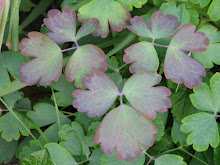When we heard that the former homeowners sprayed yearly for spiders (in addition to other things), we were dubious. Spiders are beneficial, eating mosquitoes and other pests. Their webs are pretty. They usually have interesting markings. However, now we understand...not that we would ever spray. Since we're in the woods, we have a lot of spiders. I used to brush the webs from our window frames and deck railings, but they reappear overnight.
I joked to Todd that we don't have to decorate the outside of the house for Halloween - the spiders have done the job for us. We have to be careful, too, when walking around on the property. Huge webs - the biggest I've ever seen - stretch between trees, across our driveway, and in bushes...webs that are multiple feet wide and sometimes difficult to see.
If you don't always see the big webs, sometimes you feel a feathery touch on your arm or face...that's the tripwire. The vibration of the "wire" lets the spider know that an insect may be caught, or that danger might be nearby. They also seem to anchor the web in places. It's just an added precaution, since most spiders have incredible vision.
Sometimes I'll just see an insect leg, seemingly floating in midair. It's usually caught on the remnant of an old web.
The most common spider around here is Lariniodides patagiaus, an orb weaver. With leg span, they're about quarter-sized, and build beautiful, intricate webs. The strands are sticky, easily trapping insects that bumble into the web.
We also have our fair share of funnel web spiders (family Agelenidae).
Unlike the orb weavers, their webs are horizontal, and the strands are slick, not sticky. An insect landing there can't find purchase on the smooth surface, and their struggles alert the spider. Even insects much larger than the spider are subdued by a few bites, as you can see by the photo above.
Of course, we have many spiny-backed orb weavers (Gasteracantha cancriformis), which I've talked about in recent weeks.
They look like thorns, which is part of their camouflage.
Venusta orchard spiders (Leucauge venusta) have webs that are fairly close to the ground, typically spanning the distance between two low-growing bushes, or even our patio plants.
Not only are their abdomens beautifully colored, but their legs, too, are a lovely jade color.
They are orb weavers as well.
Another favorite is the crab spider (family Thomisidae). They typically perch in flower blossoms, waiting for visiting insects.
They come in many different sizes and colors, but they always have that distinctive front leg stance.
Sometimes you don't see the spider at all...just the legs.
Despite his appearance, the Harvestman spider (Opiliones), while an arachnid, isn't a spider at all. If you examine the body closely...
...you will see that they don't have a segmented abdomen/thorax. They also do not build webs, and they don't produce venom (all spiders produce venom, although only a few are actually poisonous to humans). That black dot is the single pair of eyes that Harvestman 'spiders' have, unlike 'real' spiders, which have multiple pairs.
A true spider that I was delighted to find in our yard is Argiope aurantia, or the yellow and black garden spider.
Their legs are always oriented in a large "X" on the web, and they have a distinctive "Z" pattern woven beneath their perch.
See how the spider is positioned behind a dense circle of webbing? That is her camouflage. There are many theories about why she weaves the zig zag design...to attract prey, to warn off low-flying birds, and it might be a stabilizing feature.
Argiope aurantia are rather large spiders with large abdomens, to to 1 1/8 inches. Even so, they can subdue prey more than twice their size!
They're brightly colored and beautifully patterned.
I found three of them, on their respective webs, in an open bed at the front of the house, in one of the few sunny spots. I've had my eye on this bed for several weeks. It was full of tall, feathery plants that looked suspiciously like weeds, but I had avoided pulling them in case they were a type of fall-blooming plant. Now I know that they're weeds, but I am going to leave them up this year, because I don't want to deprive Argiope aurantia of her habitat. I greatly enjoy watching them on their webs. Sometimes insects fly into the web but are able to escape, even though Argiope aurantia rushes to detain them. She calmly eats the damaged part of the web to tidy it up...
...and goes back to waiting. She'll spin a new web the next day, so no need to cry over spilled milk. What a beauty!
When I'm grumbling to Todd about the messy look that the spiderwebs give our house and our deck, I'm going to try to remember the creatures that inhabit them...how interesting they are, and the good that they do.
Have a great week!
Subscribe to:
Post Comments (Atom)
























No comments:
Post a Comment